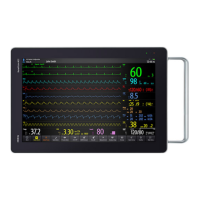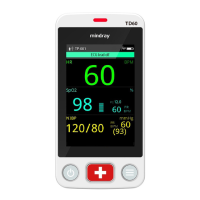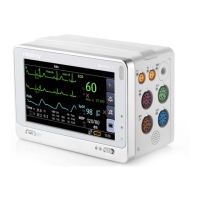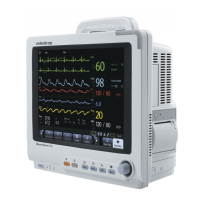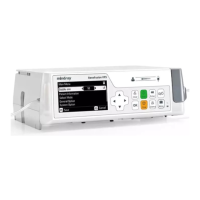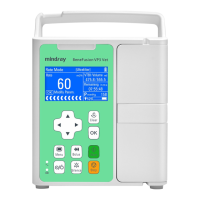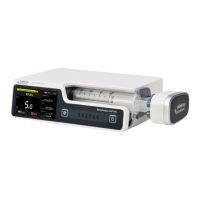BeneVision N1 Patient Monitor Operator’s Manual 7 - 9
7.5.6 Adjusting the Minimum QRS Detection Threshold
To avoid false asystole alarm due to low R wave amplitude, and to avoid tall T waves and P waves being mistaken
for QRS complexes, the monitor provides a means to manually adjust the minimum QRS detection threshold.
To adjust the minimum QRS detection threshold, follow this procedure:
1. Select the ECG numeric area or waveform area to enter the ECG dialog.
2. Select the Setup tab and set Filter to Monitor.
3. Select the QRS Threshold tab.
4. Select up or down arrow buttons to adjust the minimum threshold for QRS detection. Selecting Default
resets the QRS threshold to the default value (0.16 mV).
• The setting of the QRS detection threshold can affect the sensitivity for arrhythmia, ST, QT/QTc
detection, and heart rate calculation.
• If the QRS amplitude is low, the monitor might not be able to detect the beats and false asystole calls
may occur.
• The minimum QRS detection threshold can only be adjusted when the ECG filter is set to Monitor.
7.6 Monitoring Arrhythmia
Arrhythmia monitoring is intended for adult and pediatric patients.
7.6.1 Arrhythmia Safety Information
• Heart rate reading may be affected by cardiac arrhythmias. Do not rely entirely on heart rate alarms
when monitoring patients with arrhythmias. Always keep these patients under close surveillance.
• The arrhythmia analysis program is intended to detect ventricular arrhythmias and atrial
fibrillation. It is not designed to detect all the atrial or supraventricular arrhythmias. It may
incorrectly identify the presence or absence of an arrhythmia. Therefore, a physician must analyze
the arrhythmia information with other clinical findings.
• Atrial fibrillation (Afib) detection function is not intended for pediatric and neonatal patients.
• Since the arrhythmia detection algorithm sensitivity and specificity are less than 100%, it is possible
for false arrhythmias to be detected and true arrhythmia events to not be detected. The possibility
increases when the signal is noisy.
• The ECG size and minimum QRS detection threshold settings affect arrhythmia detection and heart
rate calculation sensitivity.
• If QRS amplitude is low, the monitor might be unable to calculate heart rate and thus create false
asystole calls. During the learning phase of the algorithm, arrhythmia detection may not be
available. It is recommended to closely monitor patient condition during, and for several minutes
after, the learning phase to allow the algorithm to reach optimal detection performance.
7.6.2 Arrhythmia Events
This section lists all arrhythmia events and their criteria.

